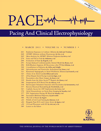Spironolactone Therapy is Associated with Reduced Ventricular Tachycardia Rate in Patients with Cardiomyopathy
Conflict of Interest: None.
Abstract
Introduction: Multiple pharmacological therapies currently in prevalent clinical use for cardiac diseases have antifibrotic properties. Spironolactone, a potent antifibrotic agent, is currently used for advanced heart failure. Therapies such as HMG-CoA reductase inhibitors (statins) and angiotensin-converting enzyme inhibitors (ACEi) also have antifibrotic properties. However, the effect of these medications on the ventricular arrhythmia phenotype is currently unknown. Therefore, we set out to define the ventricular arrhythmia rates in patients actively treated with such therapies.
Methods and Results: We retrospectively evaluated the ventricular tachycardia (VT) rates in patients with structural heart disease actively treated with therapies with antifibrotic properties. VT rates were significantly diminished in patients treated with spironolactone (158 ± 26 beats per minute [bpm], n = 21) compared to patients on no medications (205 ± 22 bpm, n = 13) or those who were on similar heart-failure therapies but not on spironolactone (186 ± 32 bpm, n = 82). In addition, we observed that VT rates showed a significant trend toward lower rates in patients receiving either statins or ACEi, compared to patients on no medical therapy. In multivariate analysis, spironolactone therapy was identified as the single most significant variable for reduced VT rate.
Conclusion: Use of spironolactone in patients with heart failure is associated with reduced VT rate. Similar but less-significant reductions in VT rates were observed with use of other pharmacological agents with antifibrotic properties, such as statins and ACEi. Our findings, at least in part, could account for reduction in sudden cardiac death rates documented with use of these therapies. (PACE 2011; 34:309–314))




